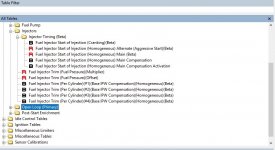Hey thanks for clicking on that link! I'm looking for some sage wisdom on CL MAF scaling with accesstuner on a stock 2018 WRX. What it seems like I'm doing is doing a best fit with the MAF sensor while holding injector specific parameters, variable valve timing, ignition timing, and stock wideband o2 sensor accuracy/latency as givens...written in stone as the way it is and must be. I assume the MAF sensors have been extensively tested and calibrated for the average production target accuracy. Possibly one of the more accurate and finessed sensors involved due to the simplicity of controlling the testing conditions. Stock, I see learned values as high as +/-8%. Is this the right approach or just an easy attack vector for the DIYer?
Tell me if i have this procedure correct;
If learned fuel trim is 7.00% (stable) at MAF voltage 2.00 (random value) which has a g/s value of 2 (random value) decrease g/s half the fuel trim learned 7.00*-0.5=-3.5 so 2*0.965=1.93 g/s as a sanity chech to make sure adjustment goes in the intended direction. So before, this MAF table dictated 2.00 g/s at 2.00 volts and was running lean because more air was entering than being dictated for, the ecu called for a fuel enrichment of 7.00%. Now, by adjusting the g/s value to a smaller value it expects less air at that voltage, allowing for the ecu to only be enriching by 3.5% more or less. Do we want the ecu to learn cut or add values? Prefer it to learn fuel cut values to err on the rich side of any blind side? It just feels like there are some other factors that weigh heavily on this like valve timing and egr.
Looking beyond that what about OL MAF scaling? Say I have finished my CL MAF scaling and begin logging for OL. How exactly do I merge the overlapping areas between Cl and OL? I would be using mafscaling-2.5.1 program or possibly accesstuner to ecu. Is OL going to require a dyno for any accuracy?
Feel free to move this thread to a more appropriate area.
Tell me if i have this procedure correct;
If learned fuel trim is 7.00% (stable) at MAF voltage 2.00 (random value) which has a g/s value of 2 (random value) decrease g/s half the fuel trim learned 7.00*-0.5=-3.5 so 2*0.965=1.93 g/s as a sanity chech to make sure adjustment goes in the intended direction. So before, this MAF table dictated 2.00 g/s at 2.00 volts and was running lean because more air was entering than being dictated for, the ecu called for a fuel enrichment of 7.00%. Now, by adjusting the g/s value to a smaller value it expects less air at that voltage, allowing for the ecu to only be enriching by 3.5% more or less. Do we want the ecu to learn cut or add values? Prefer it to learn fuel cut values to err on the rich side of any blind side? It just feels like there are some other factors that weigh heavily on this like valve timing and egr.
Looking beyond that what about OL MAF scaling? Say I have finished my CL MAF scaling and begin logging for OL. How exactly do I merge the overlapping areas between Cl and OL? I would be using mafscaling-2.5.1 program or possibly accesstuner to ecu. Is OL going to require a dyno for any accuracy?
Feel free to move this thread to a more appropriate area.
Last edited:

